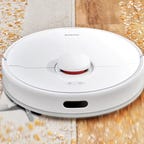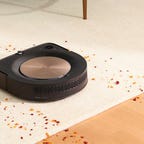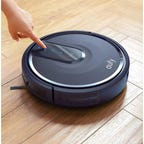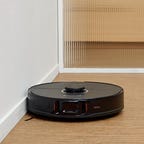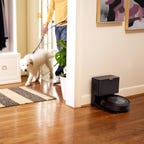Best Robot Vacuums for 2024
We've picked out the best robot vacuums after putting them through extensive testing methodologies we've fine-tuned over the years.
What to consider
Overall performance
Type of flooring you have
Pets or no pets?
Size and power
Price
Our Picks
What is the best overall robot vacuum?
When you have things to do, a robot vacuum can be a huge help. But if it can't get the job done right, then it can add to your workload. So there's an added expectation of reliability and quality. In our extensive testing, we determine suction power, ease of use, navigation, carpet and hardwood efficiency. We also have the poop test. After our tests, we can confidently say that the Dreametech DreameBot D10 Plus is best for most homes.
Because every home is different, there will be different cleaning needs. That's exactly why we've picked robot vacuum cleaners that can handle a variety of housecleaning scenarios. They can keep hardwood, tile, carpet and rugs spick-and-span, even handling tougher stuff like pet hair. Robot vacuums have to utilize a variety of sensors and even lasers to ensure the device can intelligently navigate your home and go from room to room without needing help. Being smaller doesn't mean they're less powerful either, with some models having suction that even rivals that of handheld vacuums.
Prices are definitely something to be aware of because robot vacs can set you back more than a traditional vacuum. Some higher-end models cost upward of four figures. Fortunately, there are plenty of options that we can recommend that are capable cleaners and cost a lot less. Many well-designed budget picks and models are available with tempting upgrades, including self-emptying bins, built-in mopping capabilities and advanced AI image recognition for elite-level obstacle avoidance.
Among those top models are flagship cleaners from companies like iRobot, Roborock and Dreame, as well as compelling picks from lesser-known upstart brands. CNET will continue to test robot vacuums and update this best robot vacuum list periodically as new models become available, but for now, let's get right to the top models we'd currently point you toward.
Best robot vacuums of 2024
I'll admit that I was initially skeptical of the DreameBot D10 Plus. At a retail price of $400, it offers features like a self-emptying dustbin and a built-in mopping pad, while costing hundreds less than comparably equipped cleaners. Too good to be true? A dream, you might say? Turns out, no. Although it wasn't the best at any of the skills in our slate of tests, it was powerful and versatile enough to keep up with the competition at just about every turn. It's right on par with the top robot vacuums we test on low-pile and midpile carpets, and it outperformed every other cleaner on hardwood floors except for
All of that is well worth the $500 or more that you'd spend for a comparable, self-emptying, mopping-ready model from the likes of Roomba, Roborock, or any other top brand -- but again, the DreameBot D10 Plus is available for less than $400. That makes this highly versatile floor cleaner a top-value pick, and an easy recommendation for the very top of our list.
Best robot vacuum for pet hair and plush carpets
iRobot Roomba S9 Plus
We made some major upgrades to our lab's robot vacuum test setup a few years ago, so the data from the tests that came before aren't directly comparable to our most recent models. That's a shame because the iRobot Roomba S9 Plus was a major standout from that earlier era -- particularly for its eye-popping performance on thick, plush carpets. The biggest challenge in those midpile carpet tests is picking up sand, which has an excess of fabric and fibers to cling to as the vacuum tries to suck it up. I mentioned that 50% is a good benchmark in that test, and the best cleaner in that challenge from our last two years of tests is the
On top of that, the S9 Plus aced our pet hair pickup tests, where we scatter clumps of actual pet hair donated from a friendly local groomer across all of our test floors. The Roomba S9 Plus didn't miss a single clump. It isn't as much of a standout on hardwood floors, and it doesn't include a mop at all, but if your home is filled with plush carpets and your pets are having a field day shedding fur across them, then the self-emptying Roomba S9 Plus is a perfect pick for your home.
Best robot vacuum on a tight budget
Eufy RoboVac 25C
You might not expect sufficient cleaning power from a budget-priced robot vacuum, but that's precisely what the Anker Eufy RoboVac 25C delivers. For instance, its ability to scour sand from hardwood floors (78.9%) wasn't too far below that of our top midrange pick. It's a decent performer on low-pile and midpile carpets as well, sucking up averages of 54% and 52% of sand from them, respectively. The current asking price? Just $96 at Walmart.
How did Anker cut down on costs here, anyway? The answer is navigation. Instead of relying on cameras or lasers to map out its environment, the machine bumps around the floor like a slow-motion ping-pong ball, changing direction when it encounters an object or obstacle. As a result, it took an excessive 91 minutes to finish its cleaning cycle in our test room, so don't expect it to cover your house in anything close to efficient fashion. That's more than a fair tradeoff at this bargain-bin price, especially considering what a surprisingly competitive cleaner the thing is.
Best midrange robot vacuum
Roborock S8
With a combined competitive price and solid performance paired with intelligent navigation, the Roborock S8 is an easy pick for the top midrange robot vacuum. Roborock has been cranking out excellent robot vacuums for years now, and this model handles messes wonderfully on all floor types. On top of that, it features a built-in mopping pad, which is great to have on hand for those unexpected messes in the kitchen. It isn't inexpensive at $750, but it's regularly on sale (including right now, where you can knock a whopping $250 off the price
Thanks to multiple sensors and lasers, the efficient navigation of the S8 is another strong suit. The vacuum cleaner does a great job at navigating even the most complex floorplans to ensure a thorough cleaning job. The lack of a self-emptying bin is a bit of a bummer here, although you've got other good options if that's what matters most (and you can always step up to the Roborock S8 Plus, which adds it in). Apart from that, there's not much that you're missing here, making this an excellent midrange pick, especially for homes with a variety of flooring types, including area rugs and other low-pile carpets.
Best poop-detecting robot vacuum
iRobot Roomba J7 Plus
While we're talking about pets, let's stop for a moment to consider the robo vac's mortal enemy: pet waste. If your dog makes a mess and your robot vac stumbles across it before you do, you might end up with a poo-pocalypse all over your floors (that link is safe to click, by the way, and worth it if only to read a hall-of-fame-worthy CNET lede from David Katzmaier). Fortunately, iRobot scrambled to come up with a solution. The answer? AI-powered cameras capable of recognizing and avoiding obstacles -- including piles of dog poop -- as it cleans. Its first feces-defying flagship was the Roomba J7 Plus, and sure enough, when we tested it out against an armada of unnervingly convincing fake dog poop samples, it steered clear at every turn. Meanwhile, the Samsung JetBot AI Plus promises the same poop-detecting smarts but fails to dodge the doo-doo in our tests. Advantage, iRobot.
Aside from not pushing poop across your floors, the Roomba J7 Plus excels at other things, too. It doesn't feature a built-in mop, but it's a semi-affordable self-emptying option, and an exceedingly well-rounded cleaner, boasting top-three averages on both hardwood floors and low-pile carpets. It fell short on plush, midpile carpets, so go with the
Best combination robot vacuum and mop
iRobot Roomba Combo J7 Plus
I mentioned that the otherwise excellent
It's a capable vacuum, too, and a top-five finisher on all three flooring types we test, which is something that only one other robot vacuum we've tested can claim (the also-excellent
Best robot vacuum splurge
Roborock S8 Pro Ultra
The Roborock S8 Pro Ultra is the most expensive product on this list, with a splurge-worthy price of $1,600 (frequently and currently on sale for $1,400.) However, this robot vacuum does a fantastic job of offering some seriously impressive intelligence and cleaning power to justify that price tag.
Whether you need the Roborock's vacuum dust, crumbs or hair from your hardwood floors, vinyl, rugs and carpets of varying lengths, you can rest assured the S8 Pro UIltra will get the job done. With a rated 6000Pa of suction power combined with the dual-brush sweeping system, the vacuum efficiently gathers whatever ends up on your floors without getting tangled nearly as often as some other robot vacuums.
However, what would a vacuum with Pro Ultra in its name be if sweeping was the only way the Roborock S8 Pro Ultra could clean your floors? This robot vacuum uses a new VibraRise 2.0 Mopping System to scrub 3,000 times per minute to help remove stubborn smudges on your hard floors. If your home has multiple flooring types in the areas you choose to let your robot vacuum clean, the smart 3D obstacle avoidance system and LiDAR will help recognize this and lift the mop so your carpets stay dry.
Factors to consider when choosing a robot vacuum
Budget
Before you do anything else, make sure you're clear on what you want to spend on your new vacuum. Robot vacuum models can cost anywhere from $200 to four figures, so it's important to find a set budget to prevent overspending. We recommend deciding on what features (self-emptying bins, built-in mopping capabilities and advanced AI image recognition for elite-level obstacle avoidance) fit your needs and researching what your budget can get you. That way you know what you're looking for and can ensure you're getting the best value.
Navigation and obstacle detection
Sure, many robot vacuum models have sensors to navigate around your home or apartment, but how effectively do the sensors perform? The ability for a robot vac to detect objects in its path can mean the difference between returning home to a clean house and a situation where the robot is trapped on cords or an area rug.
Certain models like the Dreametech DreameBot D10 Plus, Neato and Roborock all have powerful obstacle detection capabilities and navigate your home with efficiency.
Pets
Is there anything worse than your vacuum roller brush getting all tangled up and clogged due to a heap of pet hair? Luckily, many manufacturers make robot vacuums that are suited for cleaning up after pets. Models like the iRobot Roomba S9 Plus and the iRobot Roomba J7 Plus are adept at sucking up pet hair on both carpet and hardwood flooring as well as detecting (thankfully, avoiding pet waste). Several of the models on this list have high-efficiency filters to help eliminate allergens that may come from pet hair and dander to help with allergies.
How we test robot vacuums
Each robot vacuum we consider for recommendation gets put through its paces in our test lab in Louisville, Kentucky. In addition to test floors where we run our controlled pickup tests, we monitor each robot vacuum in a special test room filled with mock furniture to gauge how well it navigates around common obstacles. Past that, we check each robot vacuum's ability to gobble up pet hair without getting clogged or leaving loose strands behind, we take mopping capabilities into consideration, and we check to see how well it navigates fake dog messes too.
Let's dive a little deeper into the main considerations, starting with our performance tests.
Robot vacuum pickup power
When it comes to vacuuming prowess, we want to know how effective each robot is against common crumbs and other debris, and also how it fares against much smaller particles like dust, dirt and sand. To find out, we use dry, uncooked black rice as a stand-in for the crumbs and sand as an analog for finer particles.
In each case, we scatter a controlled amount across three test floors: low-pile carpet, midpile carpet and hardwood floors. Then, we take the robot vacuum, thoroughly empty its dust bin, send it to clean the affected area and finally measure the weight of whatever it managed to pick up. That gives us a pickup percentage of the full amount. From there, we repeat each run two more times and average the results.
Speaking of results, the graph above shows you how each cleaner we've tested over the past few years stacks up on hardwood floors. The iRobot Roomba Combo J7 Plus is our top-tested cleaner on that surface, picking up averages of 98% of crumbs and an extra-impressive 100% of sand. Right behind it is our top recommendation, the Dreametech DreameBot D10 Plus, which earned a close second-place finish on hardwood floors despite retailing for less than half as much as the top-finishing Roomba Combo J7 Plus.
Next up is low-pile carpet. Along with the fact that the orange bars are a lot shorter (vacuuming sand is a bigger challenge on carpets than on hardwood floors because of all the fibers the sand can cling to), note that the order of cleaners is different, with our top midrange pick, the Roborock S8, now leading the way. Different robot vacuums will have different strengths and weaknesses based on their designs, so our variety of tests help us make recommendations that are as informed and well-rounded as possible.
Finally, our midpile carpet results. Neato cleaned up in this test, with the Neato D9 leading all of our CNET-tested cleaners overall and the less-expensive Neato D8 coming in third overall. In between them is the iRobot Roomba Combo J7 Plus in second place. As with the low-pile tests, note that most of the cleaners in the top half of the graph are all relatively close to one another -- it isn't until you get to the bottom of the pack that those bars really start to shrink. That's good for you as a consumer, because it means that you've got a good variety of robot vacuums to choose from that all offer comparable cleaning capabilities across various price points.
One other reminder: These graphs cover the robot vacuums we've tested in the past few years. Robot vacuums we tested prior to that span used a slightly different test setup, so the data from those tests isn't directly comparable. I've made sure to point out the past performers that are still good buys, most notably the iRobot Roomba S9 Plus, which did particularly well on midpile carpets and remains one of our top recommendations.
These overhead long exposure shots each show the trail of a Roborock S7 MaxV Ultra as it cleans our test room. We attach glow sticks to the top of the cleaner directly above the vacuum intake to get a sense of how much coverage the vacuum offers and how intelligently it navigates. In this case, the S7 MaxV Ultra is as thorough and consistent as robot vacuums get.
Robot vacuum navigation skills
Your robot vacuum will only clean your home as thoroughly as it's capable of navigating it. The ideal cleaner will make easy work of finding its way from room to room and automatically avoiding obstacles along the way, all of which makes for proper, low-maintenance automated cleaning.
We make sure to observe each robot vacuum as it cleans in order to get a good sense of how well it navigates, but to get the best comparison from cleaner to cleaner, we take overhead long exposure shots of each one as it cleans our darkened test room, with glow sticks attached to the top of each one directly above the vacuum intake. The images that result show us light trails that reveal the robot's path as it navigates the room and cleans around our mock furniture.
Now, compare that to this next GIF, which shows you three runs from our top mopping pick, the iRobot Roomba Combo J7 Plus. Notice the difference? The Roomba was less effective at covering the entire room, missing the bottom-left corner in two out of three runs, and it had plenty of difficulty providing adequate coverage around the legs of that mock dining table, too.
In large part, it comes down to the tech at play. Over the years, we've consistently noted that robot vacuums that use laser-guided lidar navigation tend to be very good at mapping their environment and finding their way around. Meanwhile, 3D-mapping cameras with object recognition smarts can give robot vacuums an extra ability to identify and adapt to obstacles in their path. The Roborock S8 Pro Ultra uses both technologies, which helps explain why it performs so well here. Meanwhile, the Roomba relies on cameras and sensors alone, with lasers left out of the mix.
The iRobot Roomba J7 Plus delivered on its promise of steering clear of dog poop (fake or otherwise).
Still, those cameras definitely come in handy. Just watch the above GIF, which shows what happened when we put the iRobot Roomba J7 Plus to the test -- specifically, its promise of identifying and avoiding pet waste. With a variety of (I assure you, fake) dog poop scattered about a small, enclosed test floor, the Roomba did its best to vacuum the area without touching any of them. It succeeded, never bumping into any of our disgusting-looking test turds at all.
The Samsung JetBot AI Plus consistently failed our solid pet waste test. In each run, it would eventually run over or push one of our dog poop models.
Now, compare that with the Samsung JetBot AI Plus, which also promises to use its cameras to spot and avoid pet droppings. The result was, well, not great -- in each test run, it would eventually bump into one of our test piles. Thank goodness they weren't real.
Other robot vacuum products we've tested
You've seen our top picks and our test data. Now, here's a quick rundown of the rest of the robot vacuums we've tested in recent years, some of which are still worthy of consideration for some shoppers:
- AirRobo Robot Vacuum Cleaner P20: Available at Walmart for just $99, the AirRobo P20 is aimed directly at budget shoppers with a very basic design and few features of note. It finished at or near the bottom of all of our cleaning tests, so go with the even-less-expensive Eufy RoboVac 25C if you're looking for something cheap.
- Dreametech DreameBot D10S Plus: A newer, slightly fancier version of our top-recommended DreameBot D10 Plus, the DreameBot D10**S** Plus (emphasis mine) adds in a slightly larger bin that won't need to be emptied quite as much, a slight bump in suction power and a sleek, black-bodied design, all for about a hundred bucks more than the regular D10 Plus. It was a bit better on thin, low-pile carpet than that top-rated cleaner but not quite as good on hardwood floors or mid-pile carpet, which was somewhat surprising. Unless the bigger bin is of particular interest, we think you're better off saving some money and sticking with the D10 Plus.
- Dreametech DreameBot L10S Ultra: A souped-up Dreametech model that typically costs around $900, the DreameBot L10S Ultra adds in a king-size, 3L self-emptying bin and self-filling water tanks that let the thing make multiple mopping runs before needing a refill. It was only a so-so performer in our cleaning tests, getting regularly outperformed by its smaller sibling, the top-rated DreameBot D10 Plus. That model doesn't have the self-filling water tank, but at several hundred less than the L10S Ultra, it's a much better buy.
- EcoVacs Deebot 500: Priced at $280, the Deebot 500 is a basic but competent robot vacuum that offers app controls and voice compatibility with Alexa and Google. It wasn't a strong performer in our carpet tests and is priced too high to count as a budget pick.
- EcoVacs Deebot 600: Available at Walmart and other retailers for about $150, the Deebot 600 offers a slight uptick in performance over the Deebot 500, but it still sucked up less than 50% of the sand in both our low-pile and midpile carpet cleaning tests, which stops us short of recommending it.
- EcoVacs Deebot Ozmo 950: With a retail price of $800 and, as of writing this, a Best Buy clearance price of $400, the Ozmo 950 adds mopping functionality to the Deebot mix. As with other Deebots, the cleaning power didn't blow us away. Meanwhile, our top-recommended cleaner, the Dreametech DreameBot D10 Plus, is a superior performer that's less expensive than that clearance price, and it features a mop of its own and adds in a self-emptying bin.
- EcoVacs Deebot X2: Retailing for $1,245 (though typically available for significantly less), this is the fanciest and most expensive Deebot we've danced within our test lab. It vacuums, it mops, it empties its own bin, it refills its own water reservoir, and features all of the rest of the bells and whistles that you'd expect from such a costly cleaner. It wasn't a leader in any of our tests, which is disappointing at this price, but it never faltered too badly, either. The pickup percentages on hardwood floors were all decent, and its performance was passable on the carpet, too, with more than 50% of the sand sucked up in both our low- and mid-pile tests.
- Electrolux Pure i9: This cleaner features a unique, triangular design, and it incorporates 3D-mapping cameras into the mix for smarter navigation. It's still available directly from Electrolux for $499, but it was an underachiever in our cleaning tests, so we'd recommend shopping around.
- Greenworks GRV-5011: This $749 laser-guided floor cleaner performs well on hardwood floors. Couple that with the built-in mopping functionality, and it might be worthy of consideration for homes with hard floors. Performance on low- and mid-pile carpet was less than stellar, though, averaging toward the bottom of the pack in both cases.
- IonVac Smart Clean 2000: One of dozens of cheap, no-name robot vacuums available from Amazon and other online retailers, the IonVac Smart Clean 2000 was near-competent in our cleaning tests, but always just a little below average. Nothing about it stands out enough for us to recommend it.
- iRobot Roomba 694: This budget-priced Roomba can be yours for just $210, and it does a decent enough job at cleaning carpets and hardwood floors alike. It's extremely close to the Eufy RoboVac 25C in terms of performance, so if that model isn't available, give this Roomba a look as an alternative budget pick.
- iRobot Roomba i3 Plus: At $550 or less, this is an entry-level option among self-emptying Roombas, so if you just want something from iRobot that empties its own bin for as little cash as possible, give it a look. It was a middle-of-the-pack performer in all of our cleaning tests, never disappointing us but never really wowing us, either.
- iRobot Roomba i7 Plus: This is another entry-level Roomba with self-emptying smarts, and you can currently get it for a little under $600 on Amazon, though stock appears to be limited. It wasn't able to suck up much more than 25% of sand in our carpet tests, which suggests some limitations to its cleaning power.
- Lynkbey M20 Pro: A newcomer to our tests, Lynkbey's flagship cleaner is a self-emptying, mop-wielding powerhouse that seeks to take on Roborock. It was a top-three finisher in our hardwood floor tests, and an above-average finisher on low- and mid-pile carpets, though I'd note that it couldn't quite suck up 50% of the sand in either test, which is a slight red flag for performance. Still, it's a likable upgrade pick, especially if you can catch it on sale for less than the full $1,150 asking price.
- Neato D9: Nearly identical in appearance to the D8 and the D10, the Neato D9 is a powerful vacuum, particularly on thick carpets, where it leads the way in our cleaning tests among all of the cleaners we've tested in the past two years. You won't get a self-emptying bin or a mop, but if you just want something to keep crumbs and pet hair out of your carpets, it's well worth a look as an alternative to the Roomba S9 Plus, especially at its current sale price of $295.
- Neato D10: One of the latest D-shaped cleaners from Neato, the D10 promises powerful suction and room-by-room navigation smarts via the Neato app. It was a relatively strong performer in our tests, but we didn't see enough of an edge over the D8 or the D9 to justify the extra expense.
- Samsung JetBot AI Plus: You already saw it fail our poop avoidance test, and that wasn't the only place where Samsung's JetBot AI Plus came up short, with pickup percentages that ranked near the bottom in all of our cleaning tests. At $829, this tech-rich robot vacuum just isn't worth it.
- Shark IQ RV1001AE: A self-emptying cleaner that's available for less than $500 if you catch it on sale, the Shark IQ RV1001AE is worth a look as an affordable option that empties its own bin. It gathered a respectable 84% of sand from hardwood floors in our cleaning tests but failed to pick up more than 35% of the stuff in any of our carpet tests, which isn't as strong as some of our top recommendations.
- Yeedi Cube: An offshoot of EcoVacs, the Yeedi Cube is a $700 self-emptying floor cleaner with a built-in mopping mode. The "cube" in question is the docking bay, which looks like a little robot vacuum garage, up into which it empties its bin. It was a middle-of-the-pack performer on hardwood floors, and rather lackluster on both of our test carpets, which makes this pick pretty passable.
Robot vacuum FAQs
How do robot vacuums work?
How long do robot vacuums last?
How well do robot vacuums work?
For more information on FAQs, see how to properly care for your robot vacuum and how a robot vacuum stacks up versus a cordless vacuum.








